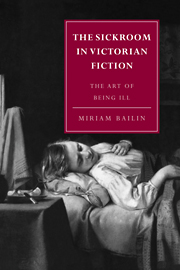2 - Charlotte Bronte: “varieties of pain”
Published online by Cambridge University Press: 24 October 2009
Summary
One need look no further than the grim facts of Charlotte Brontë's own life to account for the ubiquity in her novels of states of fever, debility, hypochondria, and morbid decline: the unremitting toll of disease upon her family, the melancholy effects of frustration and grief, her own chronic ill-health and that of the ailing father she dutifully nursed until her own early death. Illness, as Brontë herself defines and portrays it, can also be a register of deviance or alienation from social and personal norms, and in this respect, too, she was in a critical position to judge from her experience the painful effects of marginality and social aberration. As Terry Eagleton puts it: “A crisis of social identity… was endemic in this Tory, socially respectable but none too affluent family.” The Brontë sisters in particular, as Eagleton sums up their situation, were genteel in the “rough-and-ready environment” of the West Riding in Yorkshire, educated but without social or geographical access to the world which might gratify their tastes and interests, and female, “trapped … between imaginative aspiration and … a society which could use them merely as ‘higher’ servants” (8). (“A private governess has no existence,” wrote Charlotte in a letter to Emily.) Even after the success of Jane Eyre brought fame to Charlotte, her extreme shyness, her “deep and exaggerated consciousness of her personal defects,” made her shrink from the wider world she longed for.
To feel oneself a victim (or reluctant beneficiary) of forces beyond one's control, captive to one's physical being, estranged from one's essence, and at the same time continually at variance with “proper” social adaptation and functioning, are the conditions of illness and the experiential medium of Brontë's characters.
- Type
- Chapter
- Information
- The Sickroom in Victorian FictionThe Art of Being Ill, pp. 48 - 78Publisher: Cambridge University PressPrint publication year: 1994



